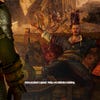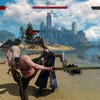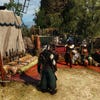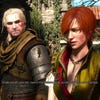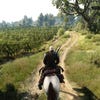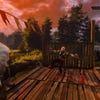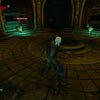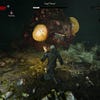The Witcher 3: Hearts of Stone doesn't quite fulfil its expansion billing
Details and impressions of Geralt's new adventures.
By calling Hearts of Stone an expansion, Polish developer CD Projekt Red set an expectation - an expectation of something grand, and something extraordinary. Ordinary, you see, is downloadable content. Expansions are rarer, bigger beasts. But in the case of Hearts of Stone, 'expansion' is misleading. Sure, it's £8, so it's not comparable to a £35 World of Warcraft expansion, and it has only been in development for around five months, but still: it doesn't quite live up to the billing.
Hearts of Stone is for level 30 characters, and there's one provided gratis if you don't have one. The main focus is a 10-hour story, which you begin by heading to a notice board marked on your map, and everything that then unfolds takes place in the same world you've already explored, albeit in less-trodden areas. As such it never feel as shiny and new as the best expansions do, and it takes a while to stand apart and resemble something more than yet another quest in an already abundant game. But Hearts does get better.
Two characters in particular stand out: the two key figures of the Hearts story. One you've met before, and I certainly never expected to see again, and the other is an immortal - something CD Projekt Red has already announced (I don't want to spoil more than that - look away from the gallery at the bottom of this article to preserve secrets). Discovering their motivations and their secrets pulls you along. There's also another romance to pursue with a character old Witcher-game fans will recognise, and doing so doesn't affect your relationship with Yennefer or Triss - it's guilt-free in that regard. And when these stories warm up, Hearts really gets going. This is CD Projekt Red relaxing after the serious work of the main game, playing around with what you think you know about how certain characters behave, particularly Geralt. At points, Hearts hits genuinely funny notes.
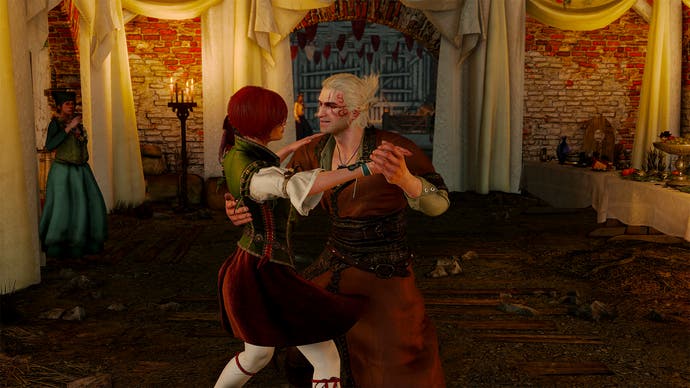
The gameplay benefits from a similar approach, as the team now has feedback about how you play, and about the kind of tactics you use. The first of two bosses I fight, in the two hours I play, has a powerful and stun-inducing stamp to penalise me for getting too close to its flanks, for instance. That was one of my go-to tactics in the main Witcher 3 game. The next boss I fight is a magic user I can barely get a hold of, which upsets my default game plan again. Hearts isn't fiendishly difficult - I play on Blood & Broken Bones and survive each battle (albeit the magic-boss fight by the skin of my teeth) - but it will challenge you.
Mechanically, not much is different. The most notable new addition are Runewords and Glyphwords, which are powerful enchantments specifically for swords and chest armour - pieces with three available sockets to use. Runewords and Glyphwords are available from an echanter who you find and unlock by completing a side-quest early in the new content. I don't do this because I am directed towards the story content at the preview event, but I ask questions about it.
There are 14 Glyphwords for chest armour and nine Runewords for swords. Glyphword examples include Glyphword Deflection, which makes your armour deflect arrows; Glyphword Protection, which activates the Quen Sign for free each time you enter combat; and Glyphword Rotation, which makes your Igni Sign blast out in a full circle around you. There's another Glyphword that can change your armour's weight category, allowing light armour-specialised Geralts to repurpose more sturdy heavy armours for instance.
The Runeword that catches my ear is one that charges your sword with a property related to whichever Sign you cast (the Sign casts as normal - the charge, which consumes an Adrenaline point, is a bonus). Casting Axii produces a stun charge; Quen produces a self-heal charge; Igni deals fire damage; Yrden slows enemies down; and Aard knocks down or stuns an enemy. The charge lasts until the end of combat.
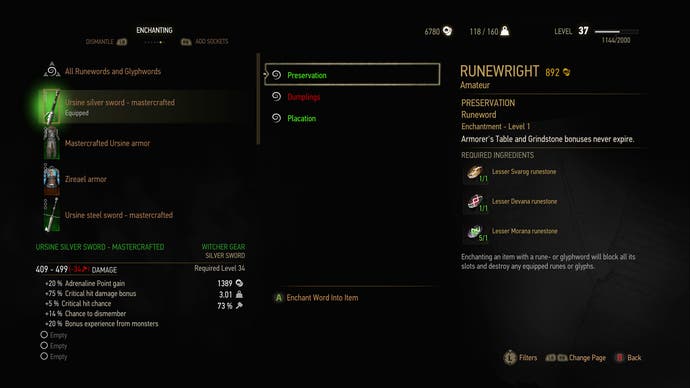
Other Runewords include Runeword Placation, which increases health regeneration when you've built up enough Adrenaline; Runeword Rejuvenation, which gives you back a bit of stamina after you kill an enemy; and Runeword Invigoration, which has properties that are best quoted (from a CDPR spokesperson): "any type of healing you do when your Vitality is at maximum will be used to increase damage of your next sword attack".
Runewords and Glyphwords are divided into three tiers and require certain runes or glyphs to create. They are not physical items but enchantments applied directly to swords or pieces of chest armour, and you unlock the more powerful tiers by spending "lots of money" with the enchanter, says the spokesperson.
In addition to Runewords and Glyphwords, there's a small mechanical change to the d-pad quick inventory system that allows you to assign two consumables to 'up' and 'down' presses. You hold down either command to cycle between items. Hearts also introduces 10 new Gwent cards, including new leader variants for each faction. Apparently it's mostly the monster faction focused on.
Hearts of Stone improves and deepens with every objective I complete, and I'm confident that several hours later it will be one of the quests I remember the game for. But there's nothing screamingly essential in what I see, or dazzlingly different - just more of the kind of thing that's come before. It's not really what I hoped for from an expansion. Nevertheless, £8 for 10 hours of carefully crafted story still looks like good value, if more story is what you desperately want. But the main event, it feels like, will be the game's second expansion due in Q1 2016: Blood & Wine.
Hearts of Stone will be released 13th October for £7.99 alone or in a £20 box with physical Gwent cards. There's a £20 Expansion Pass that includes Hearts of Stone and Blood & Wine, the latter of which will be more expensive, meaning you'll save a bit of dosh overall by buying the Pass. Blood & Wine will be $20 (there's no European pricing yet).





